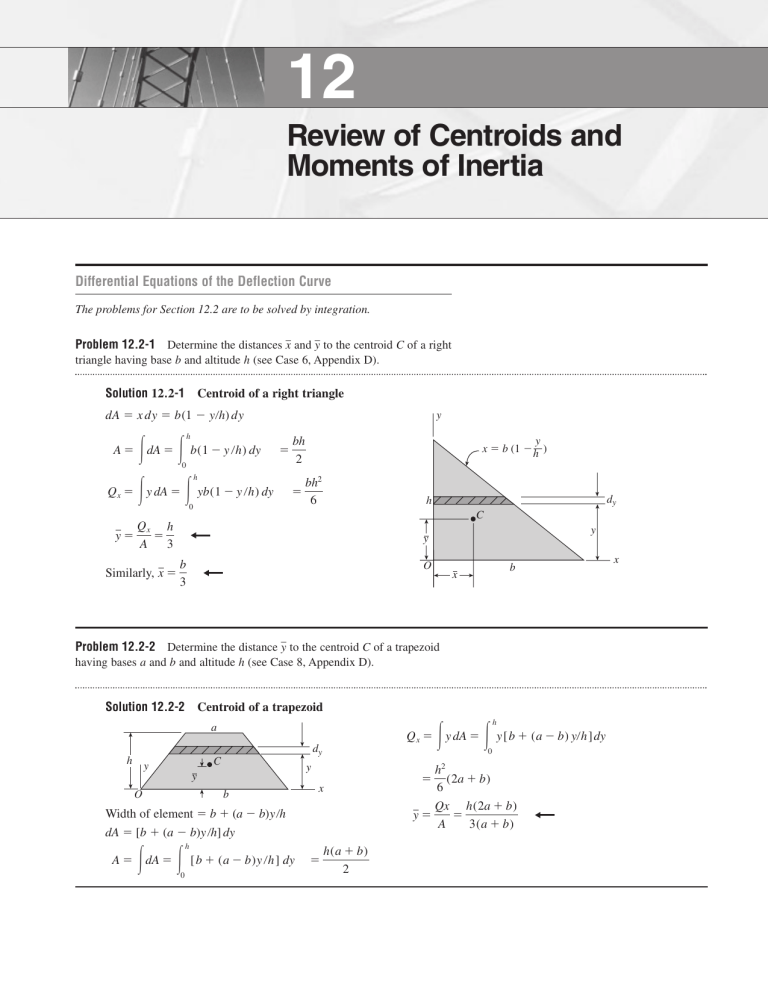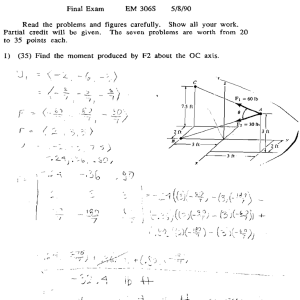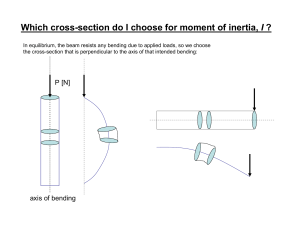
12 Review of Centroids and Moments of Inertia Differential Equations of the Deflection Curve The problems for Section 12.2 are to be solved by integration. Problem 12.2-1 Determine the distances x and y to the centroid C of a right triangle having base b and altitude h (see Case 6, Appendix D). Solution 12.2-1 Centroid of a right triangle dA x dy b(1 yh) dy A Qx y y h dA b(1 y h) dy y dA 0 bh 2 h yb(1 y h) dy 0 y x b (1 h ) bh2 6 C Qx h A 3 Similarly, x dy h y y b 3 O b x Problem 12.2-2 Determine the distance y to the centroid C of a trapezoid having bases a and b and altitude h (see Case 8, Appendix D). Solution 12.2-2 Centroid of a trapezoid a Qx dy h C y y y b O 2 x Width of element b (a b)yh dA [b (a b)y h] dy A h dA [b (a b)y h] dy 0 h(a b) 2 h y dA y[b (a b) yh]dy 0 h (2a b) 6 Qx h(2a b) y A 3(a b) x 2 CHAPTER 12 Review of Centroids and Moments of Inertia Problem 12.2-3 Determine the distance y to the centroid C of a semicircle of radius r (see Case 10, Appendix D). Solution 12.2-3 Centroid of a semicircle dA 2r 2 y 2 dy A Qx dA y r 2r 2 y 2 dy 0 r 2 2 r 2yr y dA 2 y 2 dy 0 Q x 4r A 3 y 2 r2 y2 2r 3 3 dy C y y r x O Problem 12.2-4 Determine the distances x and y to the centroid C of a parabolic spandrel of base b and height h (see Case 18, Appendix D). Solution 12.2-4 Centroid of a parabolic spandrel 2 y hx2 b dx y x A 0 Qy h C dA x Qy A y O x x 0 b hx 3 b 2h dx 4 b2 3b 4 y2 dA 2 0 2 dA ydx hx 2 bh dx 3 b2 b Qx b x dA b hx dx b2 y 1 hx 2 hx 2 bh2 ¢ 2 ≤ ¢ 2 ≤ dx 10 b b Q x 3h A 10 Problem 12.2-5 Determine the distances x and y to the centroid C of a semisegment of nth degree having base b and height h (see Case 19, Appendix D). Solution 12.2-5 Centroid of a semisegment of nth degree Qx xn hn dA y dx h ¢ 1 n ≤ dx y b A 2n 1 A Qy dA x dA b h ¢1 0 xn n ≤ n ≤ dx bh ¢ b n1 b xh ¢ 1 0 b(n 1) x A 2(n 2) Qx y dA 2 0 1 xn xn h ¢ 1 n ≤ (h) ¢ 1 n ≤ dx 2 b b 2 bh2 B xn y h(1 bn ) n0 xn hb 2 n ≤ dx ¢ ≤ n b 2 n2 Qy b y n R (n 1)(2n 1) h C y x x O dx x b SECTION 12.3 Centroids of Composite Areas Centroids of Composite Areas The problems for Section 12.3 are to be solved by using the formulas for composite areas. Problem 12.3-1 Determine the distance y to the centroid C of a trapezoid having bases a and b and altitude h (see Case 8, Appendix D) by dividing the trapezoid into two triangles. Solution 12.3-1 Centroid of a trapezoid 2h bh A2 3 2 ah bh h A a Ai (a b) 2 2 2 A1 a y A1 C C1 h C2 y A2 O x b ah 2 y1 y2 h 3 2h ah h bh h2 Q x a yi Ai ¢ ≤ ¢ ≤ (2a b) 3 2 3 2 6 Q x h(2a b) y A 3(a b) y Problem 12.3-2 One quarter of a square of side a is removed (see figure). a — 2 What are the coordinates x and y of the centroid C of the remaining area? a — 2 a — 2 C a — 2 y PROBS. 12.3-2 and 12.5-2 Solution 12.3-2 a2 4 a2 A2 2 3a 4 a y2 4 3a 2 A a Ai 4 A1 a 2 a 2 O x Centroid of a composite area y a 2 O A1 a 2 A2 a x y1 3a a 2 a a2 5a 3 Q x a yi Ai ¢ ≤ ¢ ≤ 4 4 4 2 16 Qx 5a xy A 12 x 3 4 CHAPTER 12 Review of Centroids and Moments of Inertia Problem 12.3-3 Calculate the distance y to the centroid C of the channel section shown in the figure if a 6 in., b 1 in., and c 2 in. y b b c C y B b B a — 2 PROBS. 12.3-3, 12.3-4, and 12.5-3 Solution 12.3-3 y a 6 in. y1 b c 2 2 in. b y2 0.5 in. A2 ab 6 in.2 2 A a Ai 2A1 A2 10 in.2 A1 c A2 a — 2 x A1 bc 2 in.2 b C y b a — 2 Centroid of a channel section b A1 c O O b 1 in. Q x a yi Ai 2y1A1 y2A2 11.0 in.3 Qx y 1.10 in. A x a — 2 c 2 in. Problem 12.3-4 What must be the relationship between the dimensions a, b, and c of the channel section shown in the figure in order that the centroid C will lie on line BB? Solution 12.3-4 Dimensions of channel section y b b A1 c B C y b a — 2 B A2 O a — 2 y1 b c 2 A2 ab y2 b 2 A a Ai 2A1 A2 b(2c a) A1 c A1 bc x Q x a yi Ai 2y1A1 y2A2 b 2(4bc 2c2 ab) y Q x 4bc 2c2 ab A 2(2c a) Set y b and solve: 2c2 ab y Problem 12.3-5 The cross section of a beam constructed of a W 24 162 wide-flange section with an 8 in. 3/4 in. cover plate welded to the top flange is shown in the figure. Determine the distance y from the base of the beam to the centroid C of the cross-sectional area. 3 Plate 8 in. — 4 in. W 24 162 C y PROBS. 12.3-5 and 12.5-5 O x SECTION 12.3 Solution 12.3-5 5 Centroids of Composite Areas Centroid of beam cross section W 24 162 A2 A1 47.7 in.2 d 25.00 in. y1 d 2 12.5 in. PLATE: 8.0 0.75 in. A2 (8.0)(0.75) 6.0 in.2 y2 25.00 0.75 2 25.375 in. C A1 A a Ai A1 A2 53.70 in.2 Q x a yi Ai y1A1 y2A2 748.5 in.3 y y x x Qx 13.94 in. A y Problem 12.3-6 Determine the distance y to the centroid C of the 180 mm composite area shown in the figure. 180 mm 105 mm 15 mm 30 mm 30 mm A1 C y A2 O x 30 mm 30 mm PROBS. 12.3-6, 12.5-6 and 12.7-6 Solution 12.3-6 120 mm Centroid of composite area y 180 mm 105 mm 15 mm A1 (360)(30) 10,800 mm2 y1 105 mm 180 mm A2 2(120)(30) (120)(30) 10,800 mm2 y2 0 A a Ai A1 A2 21,600 mm2 30 mm 30 mm A1 C y A2 90 mm O x 30 mm 30 mm 120 mm 90 mm 90 mm Q x a yi Ai y1A1 y2A2 1.134 106 mm3 Qx y 52.5 mm A 90 mm 6 CHAPTER 12 Review of Centroids and Moments of Inertia Problem 12.3-7 Determine the coordinates x and y of the centroid C of the y L-shaped area shown in the figure. 0.5 in. 6 in. C 0.5 in. y O PROBS. 12.3-7, 12.4-7, 12.5-7 and 12.7-7 Solution 12.3-7 4 in. Centroid of L-shaped area A1 (3.5)(0.5) 1.75 in.2 y1 0.25 in. x 1 2.25 in. A2 (6)(0.5) 3.0 in.2 y2 3.0 in. x 2 0.25 in. y A a Ai A1 A2 4.75 in.2 A2 6 in. x x Q y a x i Ai x 1A1 x 2A2 4.688 in.3 x C y O 4 in. x A1 x Qy 0.99 in. A Q x a yi Ai y1A1 y2A2 9.438 in.3 y Qx 1.99 in. A y 170 mm Problem 12.3-8 Determine the coordinates x and y of the centroid C of the area shown in the figure. 50 mm 50 mm 280 mm 150 mm 80 mm 80 mm x O 80 mm 80 mm 300 mm SECTION 12.4 Solution 12.3-8 Centroid of composite area A2 12(130)2 8450 mm2 x 2 300 130 3 256.7 mm y A2 170 130 A1 y2 280 130 3 236.7 mm 130 A3 280 A3 A4 1963 x y3 80 mm x 4 220 mm mm2 Q y a x i Ai x 1A1 x 2A2 x 3A3 x 4A4 9.842 106 mm3 x Qy A 9.842 106 137 mm 71,620 Q x a yiAi y1A1 y2A2 y3A3 y4A4 9.446 106 mm3 A1 (280)(300) 84,000 mm2 y1 140 mm y Q x 9.446 106 132 mm A 71,620 Moments of Inertia Problems 12.4-1 through 12.4-4 are to be solved by integration. Problem 12.4-1 Determine the moment of inertia Ix of a triangle of base b and altitude h with respect to its base (see Case 4, Appendix D). Solution 12.4-1 Moment of inertia of a triangle Width of element y dy b¢ dA y O y4 80 mm A a Ai A1 A2 A3 A4 71,620 mm2 A4 A1 large rectangle A2 triangular cutout A3 A4 circular holes All dimensions are in millimeters. Diameter of holes 50 mm Centers of holes are 80 mm from edges. x 1 150 mm d 2 (50) 2 1963 mm2 4 4 x 3 80 mm 150 300 O Moments of Inertia b h x Ix b(h y) dy h h y 2dA yb 2 0 3 hy ≤ h bh 12 (h y) dy h 7 8 CHAPTER 12 Review of Centroids and Moments of Inertia Problem 12.4-2 Determine the moment of inertia IBB of a trapezoid having bases a and b and altitude h with respect to its base (see Case 8, Appendix D). Solution 12.4-2 Moment of inertia of a trapezoid Width of element dy y a (b a) ¢ a dA B a (b a) ¢ h y B B x b O hy ≤ h IBB hy ≤ R dy h h y 2dA y B a (b a) 2 0 ¢ hy ≤ R dy h h (3a b) 12 3 Problem 12.4-3 Determine the moment of inertia Ix of a parabolic spandrel of base b and height h with respect to its base (see Case 18, Appendix D). Solution 12.4-3 Moment of inertia of a parabolic spandrel Width of element y dy y Bh bxbb h 2 y hx2 b b(1 y h) y O dA b(1 y h) dy x b Ix y 2dA h y 2b (1 y h) dy 0 Problem 12.4-4 Determine the moment of inertia Ix of a circle of radius r with respect to a diameter (see Case 9, Appendix D). Solution 12.4-4 Moment of inertia of a circle Width of element 2r 2 y 2 y dA 2r 2 y 2 dy dy y r C r Ix y dA y (2r 2 2 r x r 4 4 2 y 2 ) dy bh3 21 SECTION 12.4 Moments of Inertia Problems 12.4-5 through 12.4-9 are to be solved by considering the area to be a composite area. Problem 12.4-5 Determine the moment of inertia IBB of a rectangle having sides of lengths b and h with respect to a diagonal of the rectangle (see Case 2, Appendix D). Solution 12.4-5 Moment of inertia of a rectangle with respect to a diagonal L length of diagonal BB B A h1 D sin h L B b L b 2 h2 h1 distance from A to diagonal BB triangle BBC: C b L h1 bh h 1 h sin L h I1 moment of inertia of triangle ABB with respect to its base BB From Case 4, Appendix D: Triangle ADB: sin Lh 31 L bh 3 b 3h3 ¢ ≤ 12 12 L 12L2 For the rectangle: I1 IBB 2I1 b 3h3 6(b 2 h2 ) Problem 12.4-6 Calculate the moment of inertia Ix for the composite y circular area shown in the figure. The origin of the axes is at the center of the concentric circles, and the three diameters are 20, 40, and 60 mm. x Solution 12.4-6 Moment of inertia of composite area Diameters 20, 40, and 60 mm y d 4 (for a circle) 64 Ix [ (60) 4 (40) 4 (20) 4 ] 64 Ix x Ix 518 103 mm4 9 10 CHAPTER 12 Review of Centroids and Moments of Inertia Problem 12.4-7 Calculate the moments of inertia Ix and Iy with respect to the x and y axes for the L-shaped area shown in the figure for Prob. 12.3-7. Solution 12.4-7 Moments of inertia of composite area y y A2 A2 6 in. 6 in. A1 A1 O O x 4 in. x 4 in. Ix I1 I2 1 1 (3.5)(0.5) 3 (0.5)(6) 3 3 3 4 36.1 in. Iy I3 I4 1 1 (0.5)(4) 3 (5.5)(0.5) 3 3 3 4 10.9 in. y Problem 12.4-8 A semicircular area of radius 150 mm has a rectangular cutout of dimensions 50 mm 100 mm (see figure). Calculate the moments of inertia Ix and Iy with respect to the x and y axes. Also, calculate the corresponding radii of gyration rx and ry. 50 mm O 50 50 mm mm 150 mm Solution 12.4-8 150 mm Moments of inertia of composite area All dimensions in millimeters y r 150 mm 50 mm O 50 50 mm mm 150 mm 150 mm x b 100 mm h 50 mm r4 bh3 Ix (Ix ) semicircle (Ix ) rectangle 8 3 194.6 106 mm4 Iy Ix A r 2 bh 30.34 103 mm2 2 rx Ix A 80.1 mm ry rx x SECTION 12.5 Parallel-Axis Theorem Problem 12.4-9 Calculate the moments of inertia I1 and I2 of a W 16 100 wide-flange section using the cross-sectional dimensions given in Table E-l, Appendix E. (Disregard the cross-sectional areas of the fillets.) Also, calculate the corresponding radii of gyration r1 and r2, respectively. Solution 12.4-9 Moments of inertia of a wide-flange section All dimensions in inches. 2 I1 tF C 1 1 1 (10.425)(16.97) 3 (9.840)(15.00) 3 12 12 1478 in.4 d 1 1 1 bd 3 (b t w )(d 2t F ) 3 12 12 tw I2 2 ¢ 2 b I1 1480 in.4 1 1 3 ≤t b (d 2t F )t 3w 12 F 12 1 1 (0.985)(10.425) 3 (15.00)(0.585) 3 6 12 186.3 in.4 W 16 100 d 16.97 in. tw tweb 0.585 in. b 10.425 in. tF tFlange 0.985 in. say, say, I2 186 in.4 A 2(btF) (d 2tF)tw 2(10.425)(0.985) (15.00)(0.585) 29.31 in.2 r1 I1 A 7.10 in. r2 I2 A 2.52 in. Note that these results are in close agreement with the tabulated values. Parallel-Axis Theorem Problem 12.5-1 Calculate the moment of inertia Ib of a W 12 50 wide-flange section with respect to its base. (Use data from Table E-l, Appendix E.) Solution 12.5-1 Moment of inertia W 12 50 I1 394 in.4 d 12.19 in. 1 B C A 14.7 in.2 d 2 ≤ 2 394 14.7(6.095)2 940 in.4 Ib I1 A ¢ 1 B 11 12 CHAPTER 12 Review of Centroids and Moments of Inertia Problem 12.5-2 Determine the moment of inertia Ic with respect to an axis through the centroid C and parallel to the x axis for the geometric figure described in Prob. 12.3-2. Solution 12.5-2 Moment of inertia From Prob. 12.3-2: y A 3a 2 4 yc a — 2 y 5a 12 A1 xc C a — 2 A2 O a — 2 1 a 3 1 a a 3 3a 4 ¢ ≤ (a ) ¢ ≤ ¢ ≤ 3 2 3 2 2 16 Ix Ix IxC Ay2 y x a — 2 Ic IxC Ix Ay2 3a4 3a2 5a 2 ¢ ≤ 16 4 12 11a 4 192 Problem 12.5-3 For the channel section described in Prob. 12.3-3, calculate the moment of inertia Ix with respect to an axis through c the centroid C and parallel to the x axis. Solution 12.5-3 Moment of inertia y 1 in. 2 in. 3 in. yC C y From Prob. 12.3-3: 1 in. xC 1 in. 3 in. O 3 in. x A 10.0 in.2 y 1.10 in. Ix 13(4)(1)3 2(13)(1)(3)3 19.33 in.4 Ix IxC Ay2 Ixc Ix Ay2 19.33 (10.0)(1.10) 2 7.23 in.4 Problem 12.5-4 The moment of inertia with respect to axis 1-1 of the scalene triangle shown in the figure is 90 103 mm4. Calculate its moment of inertia I2 with respect to axis 2-2. 1 1 40 mm 15 mm 2 Solution 12.5-4 Moment of inertia b 40 mm C 40 mm 1 2 I1 90 103 mm4 I1 bh312 12I1 30 mm B b Ic bh336 30 103 mm4 h h h 3 1 15 mm 2 2 3 I2 Ic Ad 2 Ic (bh 2) d 2 30 103 1 (40) (30) (25) 2 405 103 mm4 2 SECTION 12.5 Parallel-Axis Theorem Problem 12.5-5 For the beam cross section described in Prob. 12.3-5, calculate the centroidal moments of inertia Ix and Iy with respect to axes c c through the centroid C such that the xc axis is parallel to the x axis and the yc axis coincides with the y axis. Solution 12.5-5 Moment of inertia d 2 PLATE 3 8— 4 in. y, yC W 24 162 xC C 1 y d 2 I–yc 1 12(3 4)(8) 3 32.0 in.4 ENTIRE CROSS SECTION Ixc I¿xc I–xc 5269 785 6050 in.4 x O I–xc 1 12(8)(3 4) 3 (8)(3 4)(d 3 8 y) 2 0.2813 6(25.00 0.375 13.94)2 0.2813 6(11.44)2 785 in.4 Iyc I¿yc I–yc 443 32 475 in.4 From Prob. 12.3-5: y 13.94 in. W 24 162 d 25.00 in. d2 12.5 in. A 47.7 in.2 I1 5170 in.4 I2 Iy 443 in.4 I¿xc I1 A(y d 2) 2 5170 (47.7)(1.44) 2 5269 in.4 I¿yc I2 443 in.4 Problem 12.5-6 Calculate the moment of inertia Ixc with respect to an axis through the centroid C and parallel to the x axis for the composite area shown in the figure for Prob. 12.3-6. Solution 12.5-6 Moment of inertia From Prob. 12.3-6: y 52.50 mm y 360 mm A1 30 mm A2 C 120 mm y A4 x O 30 mm 120 mm t 30 mm A 21,600 mm2 A1: Ix 112(360) (30)3 (360) (30) (105)2 119.9 106 mm4 A2: Ix 112(120) (30)3 (120) (30) (75)2 20.52 106 mm4 A3: Ix 112(30) (120)3 4.32 106 mm4 A4: Ix 20.52 106 mm4 A3 ENTIRE AREA: Ix a Ix 165.26 106 mm4 IxC Ix Ay2 165.26 106 (21,600)(52.50) 2 ˇ 106 106 mm4 13 14 CHAPTER 12 Review of Centroids and Moments of Inertia Problem 12.5-7 Calculate the centroidal moments of inertia Ixc and Iyc with respect to axes through the centroid C and parallel to the x and y axes, respectively, for the L-shaped area shown in the figure for Prob. 12.3-7. Solution 12.5-7 Moments of inertia y From Prob. 12.3-7: A2 yC t 0.5 in. A 4.75 in.2 y 1.987 in. 0.5 in. x 0.9869 in. From Problem 12.4-7: x 6 in. C y 3.5 in. O Ix 36.15 in.4 Iy 10.90 in.4 Ixc Ix Ay2 36.15 (4.75) (1.987) 2 xC x 4 in. 17.40 in.4 Iyc Iy Ax2 10.90 (4.75)(0.9869) 2 A1 6.27 in.4 y Problem 12.5-8 The wide-flange beam section shown in the figure has a total height of 250 mm and a constant thickness of 15 mm. Determine the flange width b if it is required that the centroidal moments of inertia Ix and Iy be in the ratio 3 to 1, respectively. 15 mm b 250 mm C x 15 mm 15 mm b Solution 12.5-8 Wide-flange beam y All dimensions in millimeters. 15 mm b 250 mm C 15 mm b b flange width 1 1 3 (220)(15) 3 ≤ (15)(b) 12 12 25 b3 61,880 (mm4) Iy 2 ¢ x 15 mm t 15 mm 1 1 (b)(250) 3 (b 15)(220) 3 12 12 0.4147 106 b 13.31 106 (mm)4 Ix Equate Ix to 3Iy and rearrange: 7.5 b3 0.4147 106 b 13.12 10 5 0 Solve numerically: b 250 mm




